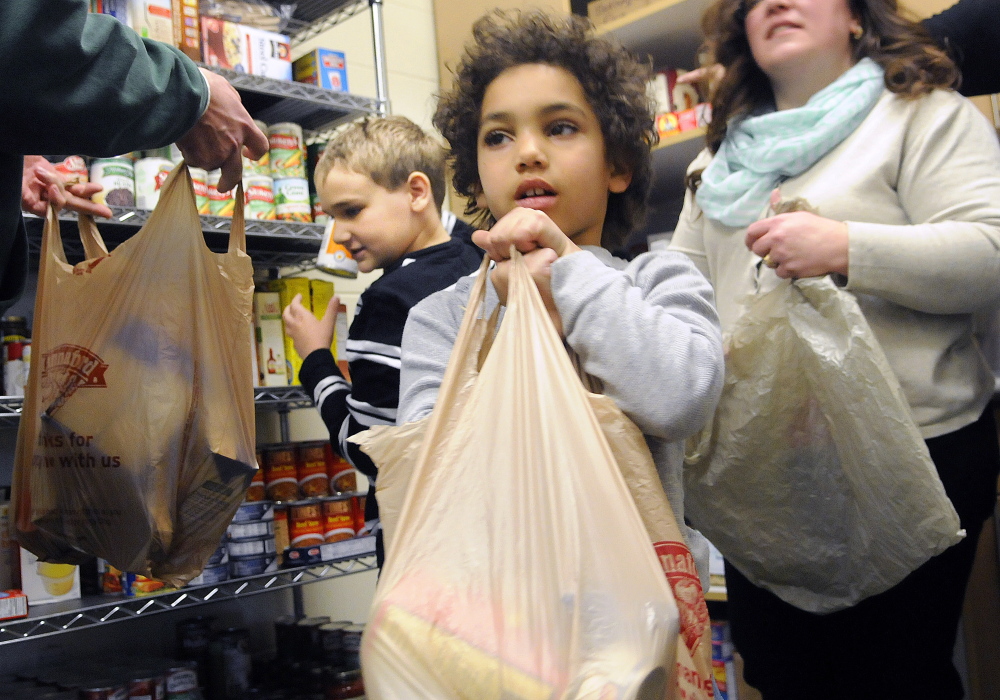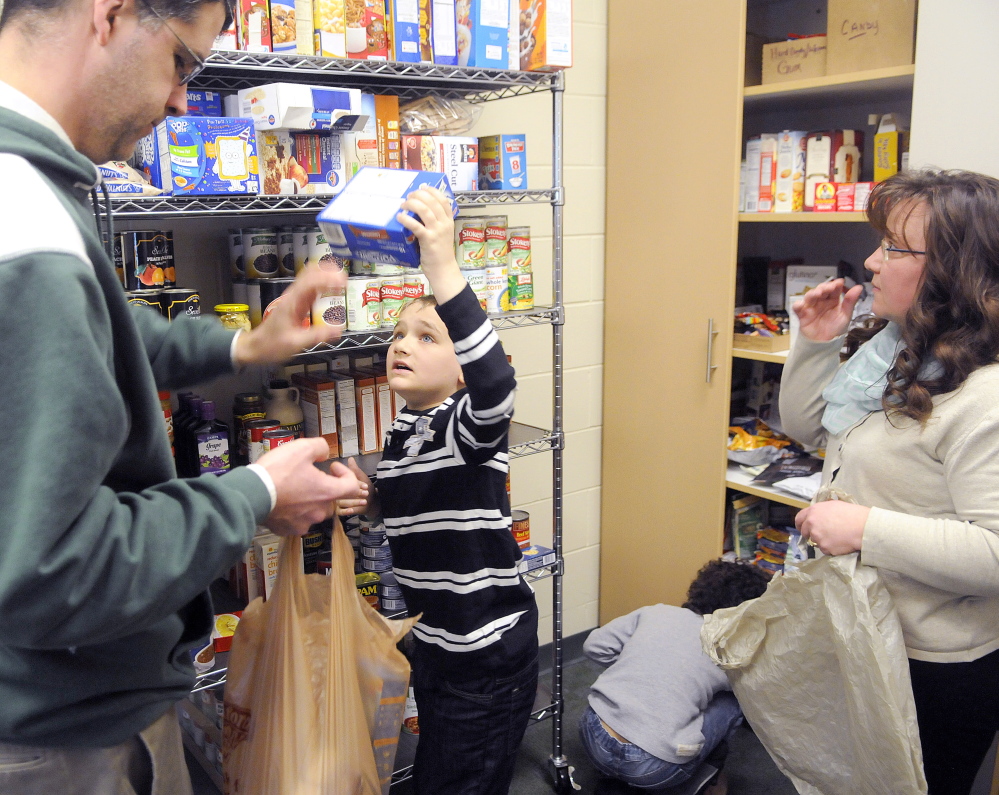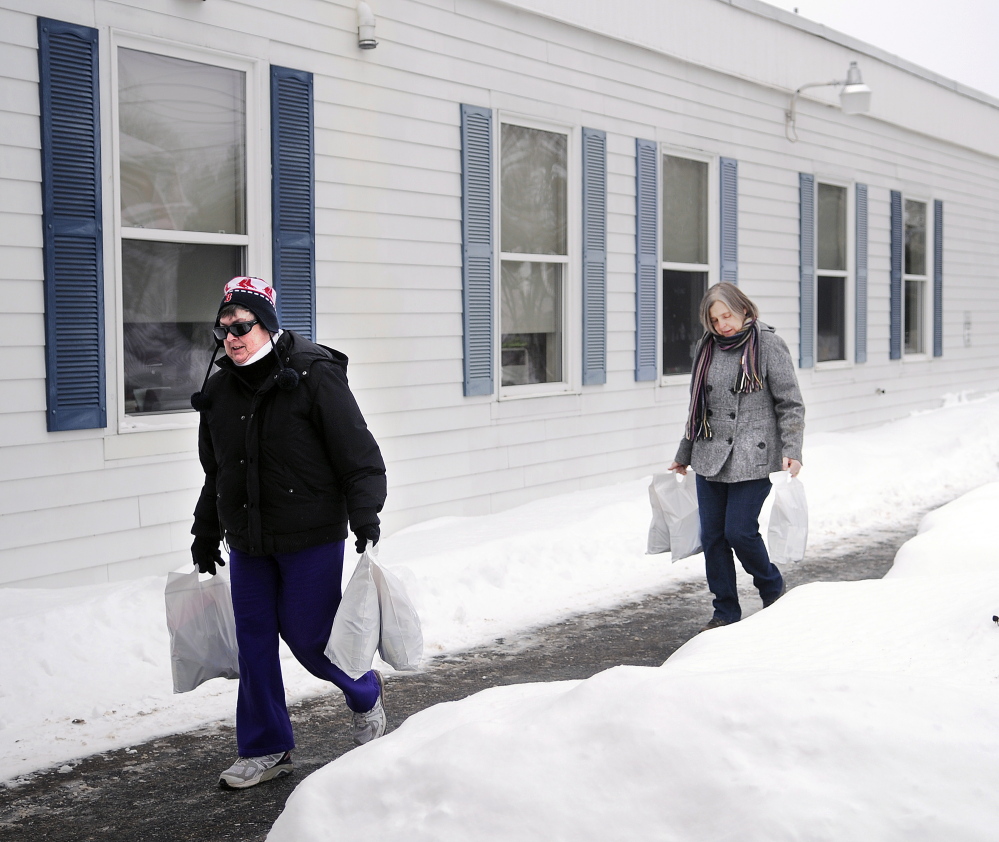Sending a bag of food home with a needy student not only fills a basic need, it opens the door to learning, said Chelsea Elementary School Principal Andrew Doiron.
“A kid that comes to school clean, well-fed and well-rested is a different student,” he said Thursday while packing bags of food for students at the school’s food pantry. “If you’re focusing on your primary human needs like hunger, you’re not going to be apt to learn that math problem or concept or what the teacher’s asking because your stomach is growling. We have to focus on the primary needs and then the educational needs after that.”
More than 80 schools across the state have programs coordinated through Good Shepherd Food Bank that provide around 2,500 kids in need with food to bring home, but those running the programs say the needs are still great in their schools.
The student food programs through the statewide hunger relief organization fit into two models: a backpack program and a food pantry in the school. In the backpack program, students receive a white bag of food near the end of each week that they bring home, providing meals and snacks for their families over the weekend.
Good Shepherd Food Bank began its backpack program, modeled after a Feeding America program, in 2010 and started coordinating school food pantry programs in 2012, spokeswoman Clara Whitney said.
At Chelsea Elementary, nearly 60 percent of its 230 students are eligible for free or reduced-price lunch. The school started a backpack program last year, but switched to a food pantry this school year because the school is able to feed more students with limited funding.
Maine has the highest percentage of child food insecurity among Northeast states, according to Feeding America’s Map the Meal Gap study. More than 64,000, nearly a quarter of Maine children, live in households without consistent access to adequate food, according to 2012 data used in the study.
Around a dozen elementary schools in Kennebec County have backpack or food pantry programs in conjunction with Good Shepherd Food Bank, an affiliate of Feeding America. The majority of the 83 schools across the state with programs are elementary schools, but some high schools and middle schools have food pantries.
Funding can be a mix of local support, grants and funds from Good Shepherd, said Shannon Coffin, program manager for the organization, which has an annual budget of $350,000 for the school programs.
Coffin said word of the success at the early schools spread throughout the state quickly, and the organization receives calls daily from schools interested in the programs. She said there seems to be more of an awareness that child hunger is a problem and there are things that can be done to help.
Study after study shows that kids not receiving proper nutrition are at a disadvantage in the classroom, leading to a disadvantage in the workplace later in life, Coffin said.
Inadequate access to food can cause stunted cognitive development in children, cascading into more problems as the kids go through school, according to a 2013 child hunger needs assessment done by the Good Shepherd Food Bank. Because the disadvantage in school can lead to a disadvantage in the workplace, Coffin said the long-term goal of Good Shepherd Food Bank is to stop the cycle of families lacking food.
“In a perfect world, none of these programs would need to exist,” she said.
In Kennebec County, Chelsea Elementary School, Hall-Dale Elementary School in Hallowell, Carrie Ricker School in Litchfield, Albert S. Hall School and George J. Mitchell Elementary School in Waterville, and Whitefield Elementary School have school pantries. All five Gardiner-based Regional School Unit 11 elementary schools and Farrington Elementary School and Sylvio J. Gilbert School in Augusta have backpack programs.
The backpack program at the Gardiner-area elementary schools was started in 2011 by Food For Thought Ministries, a group formed by members of two Gardiner churches, Gardiner Free Methodist Church and First Baptist Church.
Constance LaFlamme, secretary of the group, said they started with providing food for 40 children and are now up to 61 students. The roughly $15,000 needed to provide the bags of food to the students each year comes from grants and community businesses and groups, including the Gardiner Federal Credit Union, Gardiner Main Street and veterans organization, LaFlamme said.
The group is always looking for volunteers to help pack and deliver the bags, and people interested in donating to the cause can send donations to the First Baptist Church, she said. Food donations are discouraged because the group purchases a rotating set of four menus from Good Shepherd Food Bank, LaFlamme said.
Linda Sergent, director of food services at RSU 11, said she works with the secretaries at the elementary schools at the beginning of each school year to identify which students need the help. A lot of students look forward to getting the bags each Thursday because meals through the school are sometimes the only ones some children get, she said.
“By having this program, you know they’re maybe going to get an extra meal, those meals on the weekend they can’t afford or might not be able to have,” Sergent said.
Teresa C. Hamlin School in Randolph has the fewest number of students of the district’s five elementary schools, but nearly half of the bags of food go to students there. It has by far the highest percentage of students eligible for free or reduced lunch at 77 percent.
Susan Shepherd, principal at T.C. Hamlin, said the students and families who receive the food really appreciate the service, and she’s never seen anyone put down for receiving the bags. Each Thursday, the students will pick up the white bags of food for the weekend at the office.
“Sometimes kids will come in and just say they’re hungry. It’s not a big secret, but there’s never any stigma attached at this school,” Shepherd said.
Chelsea Elementary School, which started with a backpack program last year, now operates a food pantry in a room attached to the library. Teachers and others at the school volunteer to pack plastic grocery bags of food for the 20 to 35 kids helped each week, and parents will sometimes pick up more food if needed, said Doiron, the school principal.
He said the backpack program costs $3,750 for the first year with 15 kids, and the food pantry has allowed the school to spend only $400 since late fall. The food pantry model also works better for the school because it can provide more variety of food, Doiron said.
The school has raised money for the food pantry through events and the town gave $2,500, but the Somerville-based school district doesn’t pay anything, he said.
In recent years, Doiron said he and teachers have noticed more elementary school students coming to school with primary needs, such as food and clothing, not being met.
“Kids know there’s a need,” he said. “There’s not shock when their parents want them to bring home a bag of food. They’re appreciative of it.”
Paul Koenig — 621-5663
Twitter: @paul_koenig
Send questions/comments to the editors.





Success. Please wait for the page to reload. If the page does not reload within 5 seconds, please refresh the page.
Enter your email and password to access comments.
Hi, to comment on stories you must . This profile is in addition to your subscription and website login.
Already have a commenting profile? .
Invalid username/password.
Please check your email to confirm and complete your registration.
Only subscribers are eligible to post comments. Please subscribe or login first for digital access. Here’s why.
Use the form below to reset your password. When you've submitted your account email, we will send an email with a reset code.